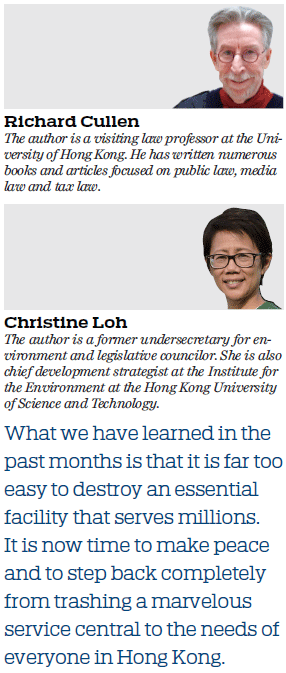Everyone must cherish our marvelous MTR
Updated: 2019-12-04 07:35
(HK Edition)
|
|||||||
Is the highly efficient MTR still beloved by the people of Hong Kong? The answer should be a resounding "yes". Yet the city this year has witnessed its horrific, willful destruction. Extremist protesters have vandalized the entire MTR system for months on end.
When protests began in June over the now-withdrawn extradition bill, most protesters relied on the MTR to move from one demonstration to another and also to escape from being caught by the police. The MTR was criticized for enabling protesters to get away so easily; as the protests continued, the MTR instituted not-unreasonable measures, such as trains not stopping at certain stations where protesting activities were occurring nearby. Once it did so, the protesters declared war on the MTR.
By early October, the MTR reported almost 90 percent of the subway stations had been badly vandalized by protesters and over 60 percent of light-rail stations as well. Some 800 turnstiles, 900 ticketing machines, 700 security cameras and 12 elevators had been seriously damaged. One of those elevators was the sole one available for immobile patients requiring access to an adjacent major hospital.

The entire MTR system had to be closed on Oct 4 because of the record level of extensive damage caused at that time. Services gradually resumed in phases after repairs were carried out. It was a massive job that was done as quickly as humanly possible so that the 5-million-plus trips per day on the MTR could continue.
Let's be clear: The MTR is a flagship Hong Kong asset. A short historical review can help remind us why this is so and why maintaining its standard is imperative not just for reputational reasons but out of economic necessity, considering its vital role as the main transport mode of the vast majority of Hong Kong citizens.
The British took full formal control of Hong Kong Island from the Qing Empire in 1842. Just over 20 years later, the world's first underground rail service (also known as "the Tube") opened in London, in 1863. It was steam-powered. Electrically powered Tube trains began operating in 1890. The system length today is about 400 kilometers with over 250 stations.
When the British began planning for a new Mass Transit Railway (MTR) in Hong Kong in the 1960s, they were able to call on over 100 years of experience in building and operating one of the most extensive and successful metros worldwide, in London. Approval for what became known as the initial MTR system was given in 1972. The first section of the MTR ran in East Kowloon, from Shek Kip Mei to Kwun Tong. It opened in October 1979. In 1980, the first MTR harbor crossing (from East Kowloon to Hong Kong Island) opened. Today the main MTR system has a track length of over 170 kilometers serving more than 90 stations. The MTR also operates an extensive, above-ground, light-rail (tram) system of 36 kilometers.
Reliability and on-time performance figures have confirmed, year in and year out, that the MTR provides one of the best mass transit rail services to be found anywhere in the world. Normally, reliability tests for mass transit travel say that on-time delivery of passengers requires that they arrive within five minutes of the scheduled arrival time. The MTR has consistently, when the system is operating under normal circumstances, achieved a remarkable 99.9 percent on-time rate.
The MTR has also provided an excellent overall template for the building of metro systems across the Chinese mainland. Beijing established a minimal city-loop metro in 1969, but the operation of more-modern metro systems on the mainland did not begin until 1984, when the Tianjin Metro (now completely rebuilt) opened its first line. Today, some 33 cities on the mainland have metro systems with a total length of over 4,600 kilometers. The three longest systems are those in Shanghai (669 kilometers), Beijing (617 kilometers) and Guangzhou (473 kilometers). All these systems have drawn, directly or indirectly, on Hong Kong's outstanding mass transit experience.
The MTR has thus proved its merit conspicuously well both in terms of performance and emulation. Almost everyone who arrived in Hong Kong over the decades following 1979 was deeply impressed with the MTR from their first encounter. If you have lived in Hong Kong, the quality is evident in all aspects of the MTR's operation: The rolling stock, the stations, the safety record, staff efficiency, the overall cleanliness of all stations and the general service was even more apparent. Moreover, the service provided was exceptional value for the money compared to most systems elsewhere, given the moderate fares charged for travel on trains, which were not just fast, reliable and clean, but also frequent.
Hong Kong people likely never thought that the wanton vandalism inflicted by the rioters on the MTR could happen in one of the top 10 safest big cities worldwide. This grim stress-testing has, though, confirmed just what an especially good public service provider the MTR is. Indeed, it has shown itself to be incomparably good, given how it has managed to maintain such steady service levels while under an unrelenting fierce attack. Hong Kong owes a greater debt than ever to the MTR - particularly to its remarkable staff and especially to those working at the point of service delivery. Those brief interruptions of service caused by the large-scale vandalism only highlight the indispensable role of the MTR in maintaining the smooth commute of countless Hong Kong workers and students.
What we have learned in the past months is that it is far too easy to destroy an essential facility that serves millions. It is now time to make peace and to step back completely from trashing a marvelous service central to the needs of everyone in Hong Kong.
The views do not necessarily reflect those of China Daily.
(HK Edition 12/04/2019 page8)